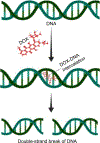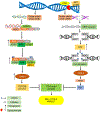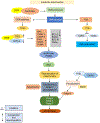Multifaced Anticancer Potential of Doxorubicin: Spotlight on Breast Cancer
- PMID: 40530298
- PMCID: PMC12173247
- DOI: 10.54457/dr.202402015
Multifaced Anticancer Potential of Doxorubicin: Spotlight on Breast Cancer
Abstract
Breast cancer is a leading cause of death among women worldwide due to its aggressive nature, early metastasis, and resistance to standard chemotherapy. Doxorubicin (DOX) is a potent anticancer drug and remains one of the most effective treatments for breast cancer. This review delves into the diverse anticancer attributes of DOX, encompassing its ability to induce DNA damage, provoke the production of reactive oxygen species, facilitate various mechanisms of cell death, and promote or enhance an anti-tumor immune response. Through an analysis of both monotherapy and combination therapy approaches, this review underscores the immense significance of DOX in contemporary breast cancer treatment. It also delves into the limitations of DOX-based therapies and provides insights into future perspectives for research and development in this field.
Keywords: Anticancer mechanism; Breast cancer; Combination therapy; Doxorubicin; Limitations; Nanoformulations.
Figures




Similar articles
-
Assessing the comparative effects of interventions in COPD: a tutorial on network meta-analysis for clinicians.Respir Res. 2024 Dec 21;25(1):438. doi: 10.1186/s12931-024-03056-x. Respir Res. 2024. PMID: 39709425 Free PMC article. Review.
-
Surveillance for Violent Deaths - National Violent Death Reporting System, 50 States, the District of Columbia, and Puerto Rico, 2022.MMWR Surveill Summ. 2025 Jun 12;74(5):1-42. doi: 10.15585/mmwr.ss7405a1. MMWR Surveill Summ. 2025. PMID: 40493548 Free PMC article.
-
Multi-Focused Acoustic Radiation Force Impulse Modulation of Murine Hepatic Xenografts Enhances Nanoscale DOX@Lip Delivery and Therapeutic Effect.Int J Nanomedicine. 2025 Jun 12;20:7359-7373. doi: 10.2147/IJN.S522247. eCollection 2025. Int J Nanomedicine. 2025. PMID: 40529535 Free PMC article.
-
Comprehensive pan-cancer analysis reveals NTN1 as an immune infiltrate risk factor and its potential prognostic value in SKCM.Sci Rep. 2025 Jan 25;15(1):3223. doi: 10.1038/s41598-025-85444-x. Sci Rep. 2025. PMID: 39863609 Free PMC article.
-
Olaparib Monotherapy or in Combination with Abiraterone for the Treatment of Patients with Metastatic Castration-Resistant Prostate Cancer (mCRPC) and a BRCA Mutation.Target Oncol. 2025 May;20(3):445-466. doi: 10.1007/s11523-025-01146-4. Epub 2025 May 21. Target Oncol. 2025. PMID: 40397306 Free PMC article. Review.
Cited by
-
Mechanistic insights into the role of RNA demethylase ALKBH5 in malignant tumor therapy.J Transl Med. 2025 Aug 13;23(1):905. doi: 10.1186/s12967-025-06938-w. J Transl Med. 2025. PMID: 40804394 Free PMC article. Review.
References
-
- Nolan E, Lindeman GJ, Visvader JE. Deciphering breast cancer: from biology to the clinic. Cell, 2023, 186(8): 1708–1728. - PubMed
-
- Bray F, Ferlay J, Soerjomataram I, et al. Global cancer statistics 2018: GLOBOCAN estimates of incidence and mortality worldwide for 36 cancers in 185 countries. CA-Cancer J Clin, 2018, 68: 394–424. - PubMed
Grants and funding
LinkOut - more resources
Full Text Sources
